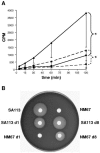In vivo survival of teicoplanin-resistant Staphylococcus aureus and fitness cost of teicoplanin resistance
- PMID: 16801412
- PMCID: PMC1489778
- DOI: 10.1128/AAC.00073-06
In vivo survival of teicoplanin-resistant Staphylococcus aureus and fitness cost of teicoplanin resistance
Abstract
Glycopeptide resistance, in a set of in vitro step-selected teicoplanin-resistant mutants derived from susceptible Staphylococcus aureus SA113, was associated with slower growth, thickening of the bacterial cell wall, increased N-acetylglucosamine incorporation, and decreased hemolysis. Differential transcriptome analysis showed that as resistance increased, some virulence-associated genes became downregulated. In a mouse tissue cage infection model, an inoculum of 10(4) CFU of strain SA113 rapidly produced a high-bacterial-load infection, which triggered MIP-2 release, leukocyte infiltration, and reduced leukocyte viability. In contrast, with the same inoculum of the isogenic glycopeptide-resistant derivative NM67, CFU initially decreased, resulting in the elimination of the mutant in three out of seven cages. In the four cages in which NM67 survived, it partially regained wild-type characteristics, including thinning of the cell wall, reduced N-acetylglucosamine uptake, and increased hemolysis; however, the survivors also became teicoplanin hypersusceptible. The elimination of the teicoplanin-resistant mutants and selection of teicoplanin-hypersusceptible survivors in the tissue cages indicated that glycopeptide resistance imposes a fitness burden on S. aureus and is selected against in vivo, with restoration of fitness incurring the price of resistance loss.
Figures



 , P < 0.05;
, P < 0.05; 
 , P < 0.01.
, P < 0.01.


 , P < 0.01 NM67 versus SA113 cell wall thickness on day 1;
, P < 0.01 NM67 versus SA113 cell wall thickness on day 1; 

 , P < 0.001 NM67 versus SA113 cytoplasm diameter on day 1; , P < 0.05 NM67 versus SA113 cell wall thickness on day 8. (B) Representative TEM pictures of SA113 (A and B) and NM67 (C and D) on days 1 (left) and 8 (right). Scale bars in the bottom right hand corners of the pictures correspond to 50 nm.
, P < 0.001 NM67 versus SA113 cytoplasm diameter on day 1; , P < 0.05 NM67 versus SA113 cell wall thickness on day 8. (B) Representative TEM pictures of SA113 (A and B) and NM67 (C and D) on days 1 (left) and 8 (right). Scale bars in the bottom right hand corners of the pictures correspond to 50 nm.
Similar articles
-
In vivo emergence of subpopulations expressing teicoplanin or vancomycin resistance phenotypes in a glycopeptide-susceptible, methicillin-resistant strain of Staphylococcus aureus.J Antimicrob Chemother. 2001 Feb;47(2):163-70. doi: 10.1093/jac/47.2.163. J Antimicrob Chemother. 2001. PMID: 11157900
-
Increased uptake and improved intracellular survival of a teicoplanin-resistant mutant of methicillin-resistant Staphylococcus aureus in non-professional phagocytes.Chemotherapy. 2009;55(3):183-8. doi: 10.1159/000215304. Epub 2009 Apr 30. Chemotherapy. 2009. PMID: 19407446
-
Modulation of fibronectin adhesins and other virulence factors in a teicoplanin-resistant derivative of methicillin-resistant Staphylococcus aureus.Antimicrob Agents Chemother. 2004 Aug;48(8):2958-65. doi: 10.1128/AAC.48.8.2958-2965.2004. Antimicrob Agents Chemother. 2004. PMID: 15273106 Free PMC article.
-
Glycopeptide resistance in Staphylococcus aureus.J Infect. 2000 May;40(3):211-7. doi: 10.1053/jinf.2000.0651. J Infect. 2000. PMID: 10908014 Review. No abstract available.
-
Fitness Cost of Antibiotic Resistance in Staphylococcus aureus: A Systematic Review.Microb Drug Resist. 2021 Sep;27(9):1218-1231. doi: 10.1089/mdr.2020.0426. Epub 2021 Jan 8. Microb Drug Resist. 2021. PMID: 33417813
Cited by
-
The fitness cost of antibiotic resistance in Streptococcus pneumoniae: insight from the field.PLoS One. 2012;7(1):e29407. doi: 10.1371/journal.pone.0029407. Epub 2012 Jan 17. PLoS One. 2012. PMID: 22272234 Free PMC article.
-
Distinct roles of Candida albicans drug resistance transcription factors TAC1, MRR1, and UPC2 in virulence.Eukaryot Cell. 2014 Jan;13(1):127-42. doi: 10.1128/EC.00245-13. Epub 2013 Nov 15. Eukaryot Cell. 2014. PMID: 24243794 Free PMC article.
-
The σB-dependent yabJ-spoVG operon is involved in the regulation of extracellular nuclease, lipase, and protease expression in Staphylococcus aureus.J Bacteriol. 2011 Sep;193(18):4954-62. doi: 10.1128/JB.05362-11. Epub 2011 Jul 1. J Bacteriol. 2011. PMID: 21725011 Free PMC article.
-
CcpA mediates the catabolite repression of tst in Staphylococcus aureus.Infect Immun. 2008 Nov;76(11):5093-9. doi: 10.1128/IAI.00724-08. Epub 2008 Aug 18. Infect Immun. 2008. PMID: 18710862 Free PMC article.
-
Systematic review and meta-analysis of the significance of heterogeneous vancomycin-intermediate Staphylococcus aureus isolates.Antimicrob Agents Chemother. 2011 Jan;55(1):405-10. doi: 10.1128/AAC.01133-10. Epub 2010 Nov 15. Antimicrob Agents Chemother. 2011. PMID: 21078939 Free PMC article.
References
-
- Archer, G. L. 1998. Staphylococcus aureus: a well-armed pathogen. Clin. Infect. Dis. 26:1179-1181. - PubMed
-
- Boneca, I. G., N. Xu, D. A. Gage, B. L. de Jonge, and A. Tomasz. 1997. Structural characterization of an abnormally cross-linked muropeptide dimer that is accumulated in the peptidoglycan of methicillin- and cefotaxime-resistant mutants of Staphylococcus aureus. J. Biol. Chem. 272:29053-29059. - PubMed
Publication types
MeSH terms
Substances
LinkOut - more resources
Full Text Sources
Other Literature Sources
Medical
Molecular Biology Databases

